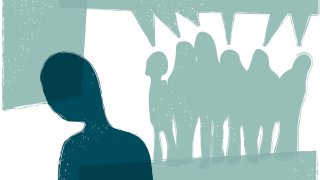
Young people dying by suicide has been an alarmingly frequent headline in recent years.
Katie Meyer, a goalkeeper on the Stanford University women's soccer team, died by suicide in 2022. She was 22. Ian Alexander Jr., son of actor and director Regina King, killed himself last year. He was 26.
In 2021, an eighth grade boy named Ellis Lariviere took his own life after being told he couldn't return to the elite private school in Brooklyn, New York, he was currently attending. He was 13.
Last year, suicide rates in the U.S. were the highest they had been since 1941, according to data from the Centers for Disease Control and Prevention.
Get Tri-state area news and weather forecasts to your inbox. Sign up for NBC New York newsletters.
During the last two decades, youth suicide has increased significantly. From 2007 through 2021, suicide rates for Americans ages 10 to 24 rose 62%, according to the CDC.
Mariana Fabiana, 22, graduated from North Carolina State University in 2023. During her senior year, 14 students died — seven of them by suicide.
Fabiana was an editor at the university paper. "One of the biggest parts of my senior year was covering student deaths," she says.
Money Report
Reentering the world after the global pandemic, she feels, was difficult for a lot of students. Many didn't know how or where to find community, and were still processing the number of deaths caused by Covid-19.
"People feel hopeless," Fabiana says.
Members of Gen Z, now ages 11 to 26, crossed into adulthood at a precarious time: A global pandemic that was both isolating and deadly interrupted their formative high school and college years. Multiple wars erupted overseas, and the U.S. economy further bifurcated into the haves and have-nots.
With tuition rates and cost of living skyrocketing, kids across the social and economic spectrum feel more pressure to be financially or professionally successful and less optimistic they'll be able to exceed their parents.
"Affluent kids have a certain set of stressors and kids from less affluence have certain stressors and it's when those factors interact with a certain set of vulnerabilities in a kid, that's when suicidal ideation will start to emerge," says Michele Berk, an assistant professor of psychiatry and behavioral sciences at Stanford University. Berk focuses on treating suicidal behavior in adolescents.
Even for young adults who seemingly have every financial or educational advantage, the current economic and political climate can fuel a kind of distress that previous generations did not face.
Young people don't think they can make 'a significant difference'
Financial instability has proven to be a large contributing factor in youth suicide. In a study of 21,000 people between ages 5 and 19, those living in the poorest areas were 37% more likely to die by suicide.
However, the trend includes young people who seem to have it all. Teens or young adults who grow up in high-income enclaves or are pursuing higher education, in theory, should have more resources and less stress than their lower-income peers.
"I can imagine people would think about kids who are affluent and think they have every advantage in life," Berk says. "Unfortunately, depression or feelings of hopelessness and suicide are something that can start internally and is not dependent on what is going on in one's life."
In Palo Alto, California, where the average household income is $200,000, the youth suicide rate was four times higher than it was nationally, according to a 2016 report from the CDC. Since then, the school district has prioritized expanding its mental health resources and trained teachers to spot signs of depression.
Selective universities are common sites of suicide. In 2017, five Columbia University students died by suicide within the first academic semester. In 2014 and 2015, suicide rates at the Massachusetts Institute of Technology surpassed the national average, which was about 13 deaths per year, according to CDC data. Columbia University and MIT both did not respond when asked for comment.
Additionally, almost 45% of high school students experienced persistent feelings of sadness or hopelessness during the pandemic and 20% seriously considered suicide, the CDC reported in 2022.
Some of this might have to do with the sociopolitical climate, says Bessel van der Kolk, a psychiatrist and author of the bestselling book "The Body Keeps the Score."
Van der Kolk, 80, says the Silent Generation had a distinct sense that they could have an impact. That's an impression Gen Z seems to have lost.
"We were extremely hopeful and thought we could change the world and so my generation actually thinks we changed the world," he says. "Kids today have much less of a vision of being able to make a significant difference. Climate change is a gigantic issue and kids know it. We are blowing up the world and very little is being done."
Affluence itself can also undermine ambition.
"Deprivation is a real motivator," he says.
It's hard to strive for more when you already have so much — and when what you have doesn't make you happy.
'The encore effect'
"The rate of suicides among young adults has been much higher than it has been historically compared to the '80s or '70s," says Carl Fleischer, co-director and medical director of the Boston Child Study Center-Los Angeles. Fleischer is a child and adolescent psychiatrist.
There are a few key contributing factors.
Social media, for example, breeds comparison on a heightened level, Fleischer says. Apps like Instagram and Facebook, which have proven to be detrimental to teen mental health, are unchartered territory for most parents. They also facilitate cyberbullying, which is much easier to hide from parents and teachers than in-person bullying. Last year, a 15-year-old in Chicago named Nate Bronstein ended his own life. It was only after his death that his parents discovered he was being harassed online.
"Social media is a very big challenge that people who were born in the '80s or '90s didn't face," Fleischer says. "By itself, it's not a cause [of depression]. It's more that kids need to learn how to navigate that place and parents have a hard time teaching them because they didn't navigate it."
Easier access to guns is linked to increased suicide rates, as well, as gun suicides reached an all-time high in 2022, according to CDC data.
Achievement culture can also turn toxic. Kids raised in affluent areas have endless opportunities, but pressure from schools and parents can communicate to them that there is only one way to succeed, Fleischer says.
"There is the all-or-nothing perfectionist thinking," he says. "It's not good enough to be second best. It's not good enough to be a good person. What matters is that you achieve certain things. But only one kid can be valedictorian, only one kid can be the best at any sport, only one kid can get that accolade."
This mentality starts well before high school, says Jennifer Breheny Wallace, author of "Never Enough: When Achievement Culture Becomes Toxic — and What We Can Do About It."
Today, kids ages 5 to 11 are asked to think about college and career choices, something that isn't "developmentally appropriate," Wallace says.
"Parents think getting their kid into a good college can act as a life vest in a sea of economic uncertainty," she says. "But what I found in my reporting is that life vest is acting like a leaded vest and drowning the kids they are trying to protect."
Kids feel from an early age that any misstep will result in disaster and that they must replicate their parents' success, a phenomenon Wallace calls the "encore effect." But the challenges young adults in the 1970s or 1980s faced were far less rigorous, she says.
"Life was generally more affordable, health care was more affordable, higher education was more affordable," she says. "There was more slack in the system. A child could make some errors, have some time to try things and drop things. There wasn't this focus on early childhood success."
Many parents would not be able to live up to the expectations they have for their children, she adds.
"A lot of parents went to prestigious colleges when the acceptance rate was 20%," Wallace says. "When my husband and I both went to Harvard, the acceptance rate was 18%. Now it's 3%. The idea that children are held to a standard that parents would not be able to meet, it's something for parents to keep in mind."
In 1980, almost 21% of those who applied to Yale University were admitted. In 2023, that number was just 4.4%. At the University of California, Los Angeles, 42% of those who applied in 1989 were admitted. In 2023, just under 9% were accepted.
'I always think they can be doing more'
Some high schools and colleges are developing a more robust mental health toolbox for students to use. The effort might be paying off. In 2022, suicide rates for people aged 10 to 14 and 15 to 24 fell by 18% and 9%, respectively, according to CDC data.
Sally Curtin, a statistician at the CDC's National Center for Health Statistics, told NPR that although this is the first decline in more than 10 years for younger age groups, it could just be a one-year fluctuation.
Palo Alto Unified School District has taken steps to address students' mental health. It employs 10 mental health associates to work at the elementary schools. Each high school has three therapists.
Teachers are instructed to "focus on things like empathy and growth mindset and kindness and managing emotions," says Dawn Yoshinaga, director of mental health and wellness at Palo Alto Unified School District.
Most of the services the school district implemented are well used. The wellness centers stationed at each middle school, for example, are very popular.
"The sixth graders are there all the time," Yoshinaga says. "Sixth-grade boys, who knew."
During the school year, the North Carolina State University administration was "pretty silent" and offered "vague statements" about the suicides, recent grad Fabiana says.
"When a student dies, by suicide or any other cause, the university undertakes a notification process called postvention. Only close contacts of the student and a small number of university officials receive notifications," North Carolina State University said in a statement to CNBC Make It.
"The process helps ensure that we are reaching those in the community who need direct support and resources, that we are being mindful and respectful of family wishes, and that we minimize the risk of suicide contagion."
Suicide contagion refers to how one suicide in a community or geographic area can lead to others also resorting to suicide.
To address the deaths at NC State, the university created a mental health task force and released an 89-page report on what additional resources the school will provide.
It's sad that so many students had to die in order for the school to do something, Fabiana says.
"I do think they are trying to do more now," she says. "I always think they can be doing more. There is always more room for improvement, but now they are doing better."
Parents can also help.
Many families who can afford a therapist or psychiatrist don't prioritize paying for one, Fleischer says.
"Financially speaking, the access is there," he says. "We have to follow through on that. Access by itself doesn't improve kids' mental health. So families that are so achievement-oriented and use their money for tutors or private school, that access is a missed opportunity."
Parents should also try to keep a "positive, nonjudgmental relationship" with their kids, Berk says. This can reduce conflict in the home, which is a contributing factor to stress.
"We want kids to tell parents how they are feeling, versus keeping that a secret and letting those thoughts increase and magnify without anybody stepping in," she says.
If you are having thoughts of suicide, please know that you are not alone. If you are in danger of acting on suicidal thoughts, call 911. If you or someone you know is struggling or in crisis, help is available. Call or text 988 or chat at 988lifeline.org.






